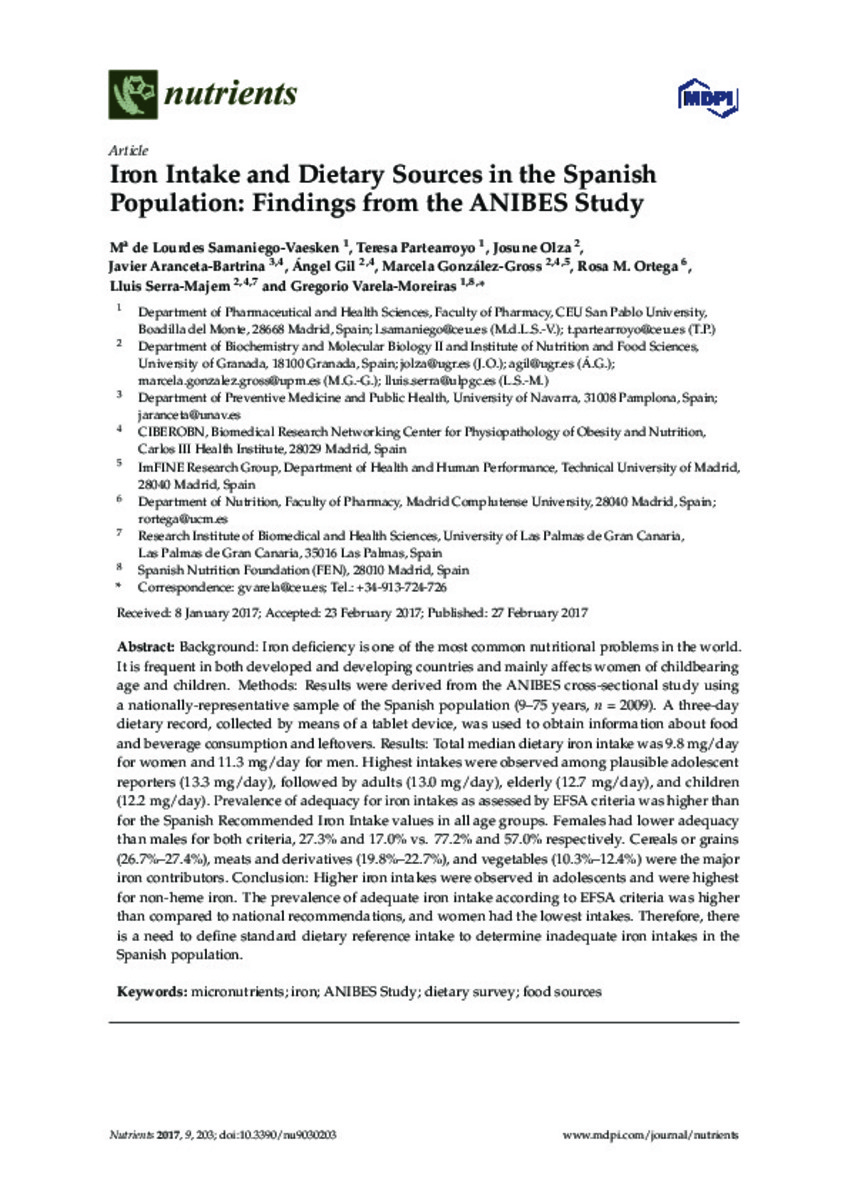Full metadata record
| DC Field | Value | Language |
|---|---|---|
| dc.creator | Samaniego-Vaesken, M.L. (María de Lourdes) | - |
| dc.creator | Partearroyo, T. (Teresa) | - |
| dc.creator | Olza, J. (Josune) | - |
| dc.creator | Aranceta-Bartrina, J. (Javier) | - |
| dc.creator | Gil, A. (Ángel) | - |
| dc.creator | González-Gross, M. (Marcela) | - |
| dc.creator | Ortega, R.M. (Rosa María) | - |
| dc.creator | Serra-Majem, L. (Luis) | - |
| dc.creator | Varela-Moreiras, G. (Gregorio) | - |
| dc.date.accessioned | 2017-04-05T08:13:44Z | - |
| dc.date.available | 2017-04-05T08:13:44Z | - |
| dc.date.issued | 2017 | - |
| dc.identifier.citation | Samaniego-Vaesken M. L., Partearroyo T., Olza J., Gil A., González-Gross M., Ortega R. M., et al. Iron intake and dietary sources in the spanish population: findings from the ANIBES study. Nutrients 2017 Feb;9(3):203. | es_ES |
| dc.identifier.issn | 2072-664 | - |
| dc.identifier.uri | https://hdl.handle.net/10171/43222 | - |
| dc.description.abstract | BACKGROUND: Iron deficiency is one of the most common nutritional problems in the world. It is frequent in both developed and developing countries and mainly affects women of childbearing age and children. METHODS: Results were derived from the ANIBES cross-sectional study using a nationally-representative sample of the Spanish population (9-75 years, n = 2009). A three-day dietary record, collected by means of a tablet device, was used to obtain information about food and beverage consumption and leftovers. RESULTS: Total median dietary iron intake was 9.8 mg/day for women and 11.3 mg/day for men. Highest intakes were observed among plausible adolescent reporters (13.3 mg/day), followed by adults (13.0 mg/day), elderly (12.7 mg/day), and children (12.2 mg/day). Prevalence of adequacy for iron intakes as assessed by EFSA criteria was higher than for the Spanish Recommended Iron Intake values in all age groups. Females had lower adequacy than males for both criteria, 27.3% and 17.0% vs. 77.2% and 57.0% respectively. Cereals or grains (26.7%-27.4%), meats and derivatives (19.8%-22.7%), and vegetables (10.3%-12.4%) were the major iron contributors. CONCLUSION: Higher iron intakes were observed in adolescents and were highest for non-heme iron. The prevalence of adequate iron intake according to EFSA criteria was higher than compared to national recommendations, and women had the lowest intakes. Therefore, there is a need to define standard dietary reference intake to determine inadequate iron intakes in the Spanish population. | es_ES |
| dc.description.sponsorship | The study was financially supported by a grant from Coca-Cola Iberia through an agreement with the Spanish Nutrition Foundation (Fundación Española de la Nutrición (FEN)). The funding sponsor had no role in the design of the study, the collection, analysis nor interpretation of the data, the writing of the manuscript, nor in the decision to publish the results. The authors declare no conflict of interest. | es_ES |
| dc.language.iso | eng | es_ES |
| dc.publisher | MDPI | es_ES |
| dc.rights | info:eu-repo/semantics/openAccess | es_ES |
| dc.subject | Materias Investigacion::Ciencias de la Salud | es_ES |
| dc.subject | Micronutrients | es_ES |
| dc.subject | Iron | es_ES |
| dc.subject | ANIBES Study | es_ES |
| dc.subject | Dietarysurvey | es_ES |
| dc.subject | Food sources | es_ES |
| dc.title | Iron intake and dietary sources in the spanish population: findings from the ANIBES study | es_ES |
| dc.type | info:eu-repo/semantics/article | es_ES |
| dc.description.note | Creative Commons Attribution License 4.1 | es_ES |
| dc.identifier.doi | http://dx.doi.org/10.3390/nu9030203 | es_ES |
Files in This Item:
Statistics and impact
Items in Dadun are protected by copyright, with all rights reserved, unless otherwise indicated.






